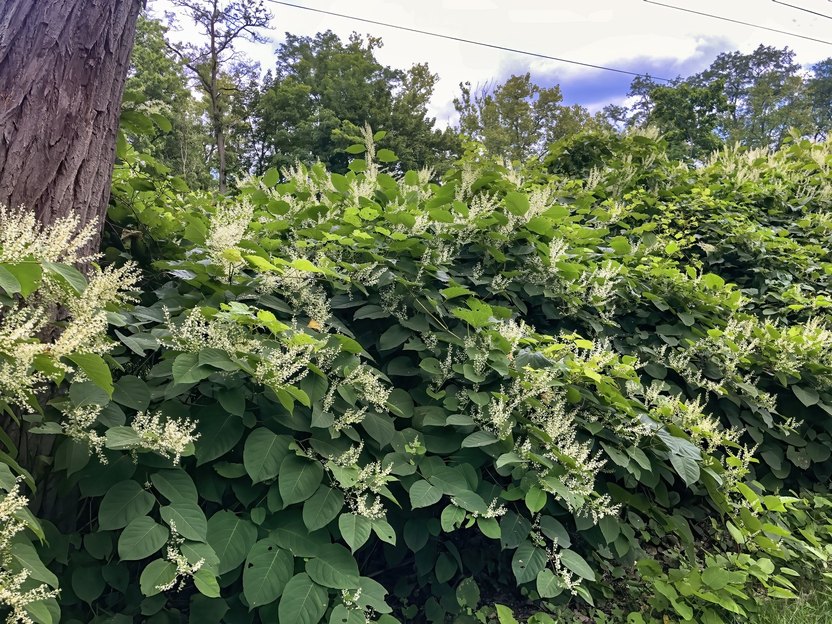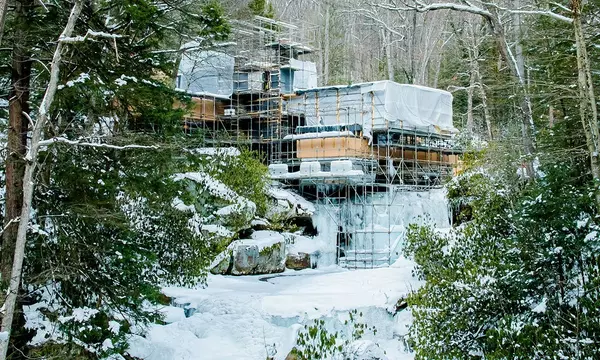Japanese Knotweed Is Coming To Wreck Your Backyard—and Much, Much Worse

Christopher Kimmel / Getty Images
The forest behind our house has turned into a horror movie, starring an armada of non-native invasive weeds. Their evil, tendrilly arms reach out like bright green zombies to smother everything in their path, albeit very slowly. Our trees have been encircled, their leaves dying before our eyes. Our pear tree silently screams for help.
I called our landscaper to confirm, pretty please, that we were not in the grips of a demonic plant that has been colonizing our area: Japanese knotweed.
If you’ve never heard of Japanese knotweed, count your blessings. It was brought to the U.S. from Japan in the mid-1800s by shortsighted botanists who also brought over kudzu and oriental bittersweet. Japanese knotweed and its pals promptly spread, unhindered by its natural predators. Knotweed is now all over the U.S., though it is partial to watery areas with disturbed soil and as little as possible obstructing its plans for world domination.
Japanese knotweed looks like a clumpy, bushy bamboo plant. Its white flowers, which appear in late summer, are beautiful. The plant requires almost no care to thrive and does so very quickly. These qualities made them very popular with gardeners ignorant to the weed’s inherent evils.
Its stalks can grow up to 3 feet a week. Its underground stems, or rhizomes, can expand by multiple feet each growing season, which runs from spring to early fall. It pushes out native plants unfortunate enough to live on land it covets. It is relentless and strong and its roots can send up shoots that can push over retaining walls, lift up walkways and road surfaces and grow up through cracks in asphalt and concrete foundations, where it can wreak structural havoc.

Ali Majdfar / Getty Images
The rhizomes are nearly impossible to eradicate. They must be physically, and entirely, excavated from the dirt or poisoned with pesticide. Neither option is easy or fast—both typically take at least three years to keep it from sprouting anew, according to Robert Naczi, the curator of North American botany at the New York Botanical Garden. A new plant can sprout from a tiny root fragment. If you manage to remove every morsel, great care must be taken in its disposal or it’ll take root wherever it ends up, like an MLM salesperson.
It can live in wet or dry conditions, near freshwater or salt, disturbed or undisturbed soil, cold or warm climates. It’s the O.G. Audrey II.
“You have to respect this plant,” says Naczi. He’s been respecting it up close and personal lately: his neighbor has an infestation that might breach his property line if it isn’t dealt with soon. “They’re known to grow inches per day in the spring.”
The U.K., where it is far more rampant, has basically given up on eradication, calling it an unrealistic goal. When the Brits give up, you know it’s bad.
Until recently, some U.K. banks wouldn’t give mortgages for homes that had the plant growing on the property. However, after gallons of legislative ink was spilled and hours of Vogon-like study conducted by various official U.K. bodies, it was announced in 2020 that Japanese knotweed wasn’t the herby Armageddon everyone thought it was, as long as it is monitored and treated.
That’s not to say it isn’t horrible. U.K. home sellers are legally required to disclose the presence of knotweed during a sale. Homeowners can be prosecuted for causing it to spread into the wild. Residents who find it on their land are advised to take out knotweed insurance, a five- to 10-year policy that pays for the annual treatment that, at best, will keep it at bay. Still, even with the new chill-out directive, knotweed’s presence on or near a property, even with proper maintenance in place, negatively impacts home values.
The U.S. isn’t quite so tizzied by knotweed, but botanists are worried when it shows up. And it shows up all over the place.
Caitlin and Paul Maher Jr., both writers, moved to Lubec, Maine, from New Hampshire in 2020. Before buying the new home, Paul didn’t ask what the acre-sized patch of 8-foot-tall foliage was on the 1.5-acre property.
Turns out it was a metric buttload of Japanese knotweed.
“It was a Vietnam jungle. I couldn’t even walk through there. It was impenetrable,” he says. Their first summer there, he had it mowed down, burned the stalks, and leveled out the ground. He later noticed knotweed sprouting through a crack in his garage floor. It was clear that he was not dealing with an ordinary plant.
The following summer, Paul scythed it to deprive it, he says, of the leaves it needs for photosynthesis, a process that left him with a torn rotator cuff and the need for surgery. Despite his initial resistance to using herbicides, he applied a solution to the foliage at the end of the growing season.
He repeated this madness for three years. Today, the knotweed is almost gone, but he has yet to declare total victory. He still has to treat little “scout” plants that pop up, which he likens to nuclear-war survivors sticking their heads out of a fallout shelter to see if the coast is clear. They inevitably sprout up underneath thorny plants such as blackberries that make it difficult to get at them. “I don’t think it’s a coincidence,” he says. “I call it plant consciousness.”
Researchers such as Dr. Bernd Blossey, a professor in the Department of Natural Resources and the Environment at Cornell University in Ithaca, N.Y., says one treatment for smaller patches of knotweed is mowing it repeatedly to keep it in check. If elimination is your aim, dig it up, ensuring that every single speck of the root is accounted for. Expect to repeat that process for years before it’s completely gone.
Another method is to cut it down after it flowers, but before it loses its leaves, and inject herbicide into every open stalk using a herbicide-injection gizmo. “It looks like a little pistol with a syringe on top,” Blossey says. The type and strength of herbicide used in this surgical strike depends on whether the stand is near water, wildlife and other sensitive environmental factors. It’s time consuming and experts suggest outsourcing this to a certified pesticide applicator. For large infestations, some specialists recommend spraying the foliage with pesticide when it begins to flower, though others say it’s not effective unless done in conjunction with stem injection.
Invasive knotweed may soon meet its match, though, thanks to one of its old frenemies in Japan: a bug called Aphalara itadori, a type of psyllid that eats Japanese knotweed.
After decades of research, scientists in the Department of Environmental Conservation at the University of Massachusetts in Amherst received permission in 2020 to release them into the wild. They began placing the bugs on individual knotweed plants covered with netting to make sure they performed as expected.
The critters are doing a number on giant knotweed, which is also going gangbusters in the U.S. “I’ve never been so excited to see a plant suffering before,” says Jeremy Andersen, a research assistant professor working on the project. “They looked like their life essence had been sucked out of them.”
So far, researchers haven’t yet seen the same results with Japanese knotweed. Andersen thinks the bug colonies on those plants weren’t propagating well in the Massachusetts climate. They are now testing a variant of the bug from a colder region of Japan, and will evaluate the results this fall. Andersen estimates that a bug-powered solution is probably three to four years away.
Fortunately for me, our landscaper Dan Philos-Jensen, owner of Salt Meadow Farms in West Barnstable, Mass., pronounced that our current backyard bête verte, as it were, is not Japanese knotweed. It is oriental bittersweet, which is so badass that even conservation organizations advise: “Nuke the bastards.”
Sadly, Philos-Jensen says it’s a matter of time before Japanese knotweed shows up in my yard—apparently, there’s a small stand growing on the other side of the farm across the street.
I can almost hear it from my front yard—“Feeeeeed me, Seymour…”
Categories
Recent Posts











676 N Michigan Ave. Ste 3010, Chicago, IL, 60611, United States